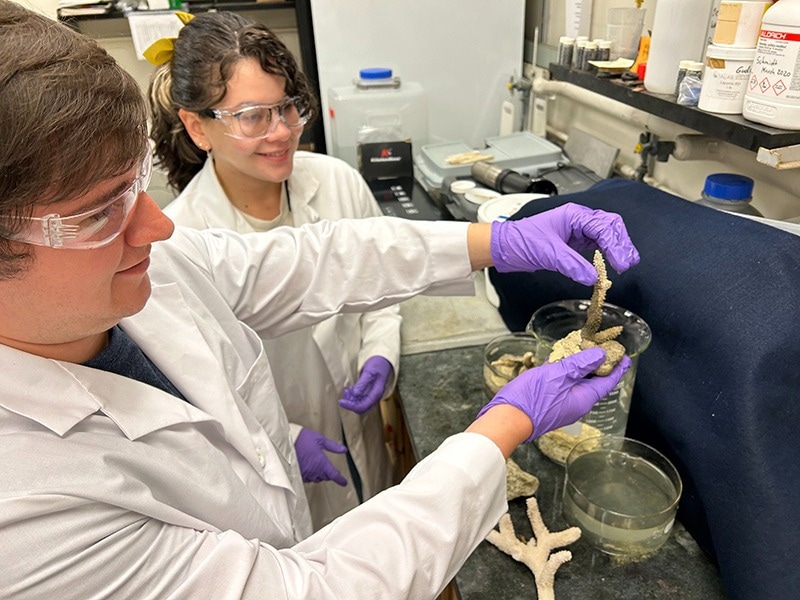Patent-pending adhesive formulations developed at Purdue University using fully sustainable, bio-based components are able to establish bonds that become stronger when submerged underwater or exposed to wet conditions.

Aaron Mena (left) and Jennifer Garcia Rodriguez, graduate students in Purdue University’s Department of Chemistry, affix corals using adhesive formulations developed from fully sustainable, bio-based components. The formulations could have applications in the construction, manufacturing, biomedical, dental, food, and cosmetic industries as well as coral reef restoration. Image Credit: Purdue University photo/Gudrun Schmidt.
Gudrun Schmidt, an Associate Professor of Practice in Purdue University's Department of Chemistry, along with a team of researchers, developed these formulations using zein, a protein found in corn, and tannic acid. A paper detailing the team's research was published in the peer-reviewed journal ACS Applied Materials & Interfaces.
These adhesive formulations hold vast potential for various applications, including coral reef restoration, as well as in the fields of construction, manufacturing, biomedical sciences, dentistry, and the food and cosmetic industries.
Stronger in Water
Schmidt and her team conducted adhesive experiments in underwater environments, evaluating their formulations on various surfaces and in different water types. These included seawater, saline solution, tap water, and deionized water.
Interestingly, the water type does not influence performance a great deal, but the substrate type does. An additional unexpected result was bond strengths increasing over time when exposed to water, contradicting general experiments of working with traditional, petroleum-based glues. Initial adhesion underwater was stronger compared to benchtop adhesion, suggesting that water helps to make the glue stick underwater.
Gudrun Schmidt, Associate Professor of Practice, Department of Chemistry, Purdue University
A protective skin forms on the surface of the adhesives when placed underwater, preventing immediate water ingress into the rest of the material.
“But once the skin was in place, it could be broken to induce faster bond formation,” Schmidt notes.
The investigations revealed that the highest level of bonding occurred at approximately 30 ºC, with another increase observed at elevated temperatures.
Schmidt emphasized that the production process for these adhesive formulations is relatively short.
We can use inexpensive, sustainably sourced, plant-based materials to make gallons of glue within hours. The adhesives are very simple to make in the lab or outdoors, everywhere on the planet.
Gudrun Schmidt, Associate Professor of Practice, Department of Chemistry, Purdue University
The Demand for Nontoxic Formulations
Schmidt stated that other researchers are developing adhesives designed to mimic the glues utilized by mussels, barnacles, oysters, and sandcastle worms for adhesion to seafloors and other wet surfaces. However, the most effective formulations among these are entirely synthetic.
Lengthy syntheses with the use of harsh chemicals may hold back their future development. Nontoxicity, sustainably sourced materials and minimal environmental impact are increasingly in demand. Consequently, several groups have turned to developing new and remaking old adhesive systems using bioinspired or bio-based chemistry.
Gudrun Schmidt, Associate Professor of Practice, Department of Chemistry, Purdue University
The growing demand for non-toxic materials has driven the development of adhesives tailored for biomedical purposes. These resulting adhesives possess characteristics akin to soft tissue. Schmidt also noted that bio-based adhesives offer broader potential applications.
“Once the in vivo and biomedical realm is left behind, there is an entire world of other applications requiring metals, plastics, wood, and inorganic substrates that need adhesives to work in the presence of water,” Schmidt says.
Schmidt notes, “Food, oral, and cosmetic applications are less restrictive when it comes to purity of starting materials. Food-grade polymers can often be used for making wet adhesives. We also are working on dental applications, trying to make bonds in this wet and challenging environment.”
Coral Reef Restoration
Schmidt mentioned that another particularly intriguing application for the patent-pending adhesive formulations developed at Purdue is the restoration of coral reefs.
Schmidt adds, “There are several major efforts, worldwide, planting young corals to replace those structures that are already dead. A major hindrance to these efforts is lack of suitable underwater adhesives that work well for this application.”
Schmidt and her research team are collaborating with the Coral Restoration Foundation, sending a range of formulations away to be tested.
Schmidt hints, “We recently visited the Florida Keys to test a few formulations in bucketsful of ocean water. It is great to see our work outside of the research lab and in the real, wet world.”
Phanor H. Montoya-Maya, the Coral Restoration Program Manager at CRF, highlighted that the foundation is continually seeking the most efficient and effective techniques for transplanting coral onto reef sites.
Montoya-Maya says, “Having different alternatives means different species and habitats can be outplanted with positive results. Science collaborations like this allow us to test and fine-tune methods before mainstream restoration. Field preliminary results are very encouraging, and we'll continue to provide feedback to Purdue researchers to ensure the final product is consistently successful across multiple restoration goals.”
Schmidt shared details of the adhesive formulations with the Purdue Innovates Office of Technology Commercialization, which has initiated the process of patent application to safeguard intellectual property.
Journal Reference:
Schmidt, G., et al. (2023). Underwater Bonding with a Biobased Adhesive from Tannic Acid and Zein Protein. ACS Applied Materials & Interfaces. doi.org/10.1021/acsami.3c04009.